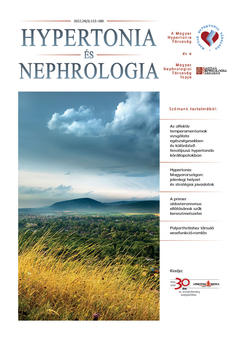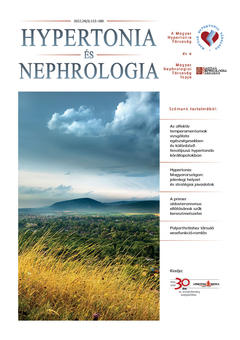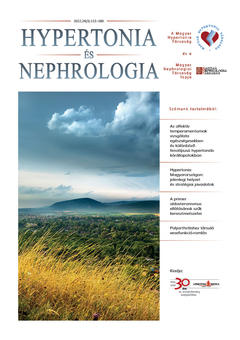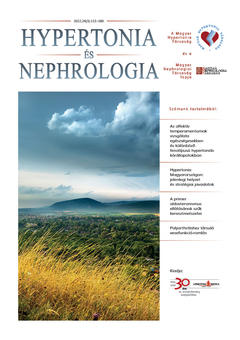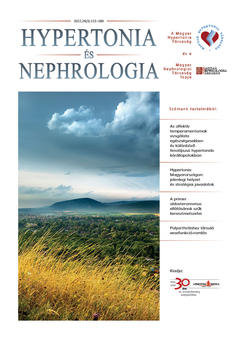The eLitMed.hu medical portal uses computer cookies for convenient operation. Detailed information can be found in the Cookie-policy.
Hypertension and nephrology - 2022;26(03)
Content
[Evaluation of affective temperaments in healthy controls and in different hypertension phenotypes]
[Affective temperaments (depressive, anxious, irritable, hyperthymic and cyclothymic) are stable parts of personality and describe the emotional reactivity for external stimuli. Their relation to psychopathological conditions is obvious, and increasing amount of data is available in cardiovascular disorders. The aim of this study was to evaluate affective temperaments in healthy subjects (Cont), in white-coat hypertensive (WhHT), in non-resistant (non-ResHT) and in resistant hypertensive (ResHT) patients. In this cross-sectional study, 363 patients were included: 82 Cont, 44 WhHT, 200 non-ResHT and 37 ResHT. The patients completed the Temperament Evaluation of Memphis, Pisa, Paris, and San Diego Autoquestionnaire (TEMPS-A). In ResHT cyclothymic affective temperament points (4 [2.25–8]) were higher (p<0.05) compared with Cont (2 [0–5]) and with non-ResHT (3 [1–5]). Cyclothymic temperament points of WhHT (4 [2–7]) were also higher compared with Cont. ResHT was independently associated with cyclothymic scale equal or above 6 (Beta=2.59 [95% CI: 1.16–5.77]), irritable scale equal or above 7 (Beta=3.17 [95% CI: 1.3–7.69]) and anxious scale equal or above 9 (Beta=2.57 [95% CI: 1.08–6.13]) points. WhHT was also independently associated with cyclothymic scale equal or above 6 points (Beta= 2.378 [95% CI: 1.178–4.802]). In conclusions, white-coat and resistant hypertensive patients have specific affective temperament patterns, and their evaluation can help to understand the psychopathological background of these conditions.]
[Effect of hypertension and RAS-inhibitors to adult patients (over 18 years old) with severe acute respiratory syndrome coronavirus 2 (SARS-CoV2) infection who were admitted to hospital]
[Our aim was to assess the prevalence of treated HT, the number of antihypertensive agents, especially ACE-inhibitors or ARBs among Covid-positive patients older than 18 years admitted to the Center for Disease Control of Department of Medicine of the University of Szeged. Data of 165 randomly selected patients (mean age 59.9±12.9 years, mean BMI 30.7±6.6 kg/m2) were analysed retrospectively. They were admitted between middle of February and end of April 2021. At the time of admission there were 103 (62.4% of all) HT patients (56 men, 47 women). The mean number of antihypertensive drugs were 1.6±1.6 pieces (max. 6) at the time of admission. 23 patients took more than 3 antihypertensives and 25 patients took exactly 3 drugs at home, and 20 patients had monotherapy. The antihypertensive therapy did not change in 74 cases, decreased in 6 cases and increased in 31 cases. In one case we could reduce therapy with 100%, monotherapy was finished, in the other 5 cases it was reduced by 50%. HT patients spent more days in hospital than non-HT patients (10.9±6.8 vs. 9.2±6.3). Spontaneous oxygen saturation (SatO2) was lower in HT patients compared to non-HTs at admission (89.6±9.7 vs. 92.6±4.8%) and patients who were on ARBs had the lowest SatO2 (87.5±8.5%, p=0.01 vs. non-HT). The total mortality rate was 8.7% in HT patients and it was just 1.6% in non-HT patients. 16.3% of HT patients with RAS-inhibitors and 13.0% without it required admission to the intensive care unit. The mortality rate was 10% of patients with RAS-inhibitors and 4.3% of them without it. This rate was 13% in patients with ARB and 8.8% with ACE-inhibitor. According to our results, HT may have higher risk for worse Covid-19 outcomes, including RAS-inhibitors also may have a higher risk.]
[Bottlenecks in primary aldosteronism care – focus on screening and biochemical diagnosis]
[ The primary (hyper) aldosteronism (PA) is a spectral disease forming a continuum from normotensive to cases that warrant adrenalectomy. PA definition is laden with inherent uncertainties. The main paradigm shift in the two new recommendations described below is that no change in medication is recommended before PA screening, to help broaden the scope of screenings. Both continue to be based on suppressed renin activity, but the serum aldosterone threshold has been lowered to increase sensitivity. With this algorithm, however, the proportion of positive screenings is significantly increased, creating another bottleneck, leading to congestion of patients referred to a specialist to perform an additional suppression test.]
[Administering single pill fixed combinations twice a day in the antihypertensive therapy]
[Optimizing the antihypertensive therapy usually does not mean simplifying the therapy. Most current antihypertensive agents have a 24-hour effect according to the prescribing information, but are not able to provide adequate blood pressure control in many patients. Among treated HT patients, a higher proportion of non-dippers occur in those who take all their antihypertensives at the same time in the morning. The recent evidence suggests that better blood pressure lowering results can be achieved when ACEis or ARBs are administered in the evening and not in the morning. There is hardly any data and practically no evidence that single pill fixed combinations should be administered twice daily, either in the same form in the same or in different doses, or two different combined drugs.]
1.
Clinical Neuroscience
Is there any difference in mortality rates of atrial fibrillation detected before or after ischemic stroke?2.
Clinical Neuroscience
Factors influencing the level of stigma in Parkinson’s disease in western Turkey3.
Clinical Neuroscience
Neuropathic pain and mood disorders in earthquake survivors with peripheral nerve injuries4.
Journal of Nursing Theory and Practice
[Correlations of Sarcopenia, Frailty, Falls and Social Isolation – A Literature Review in the Light of Swedish Statistics]5.
Clinical Neuroscience
[Comparison of pain intensity measurements among patients with low-back pain]1.
Clinical Neuroscience Proceedings
[A Magyar Stroke Társaság XVIII. Kongresszusa és a Magyar Neuroszonológiai Társaság XV. Konferenciája. Absztraktfüzet]2.
3.
Journal of Nursing Theory and Practice
[A selection of the entries submitted to the literary contest "Honorable mission: the joys and challenges of our profession" ]4.
Journal of Nursing Theory and Practice
[End of Life and Palliative Care of Newborns in the Nursing Context]5.
Journal of Nursing Theory and Practice
[Aspects of Occupational Health Nursing for Incurable Patients ]